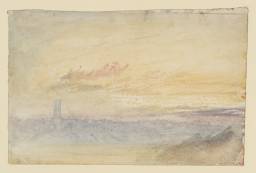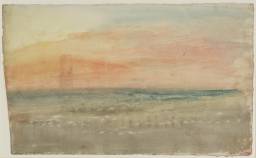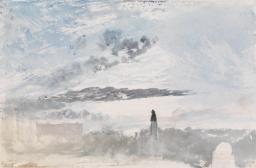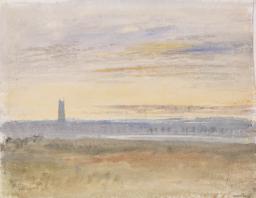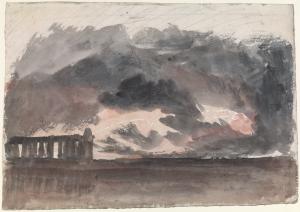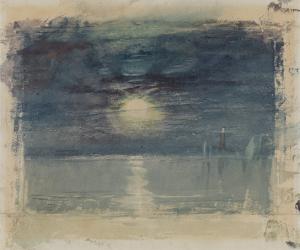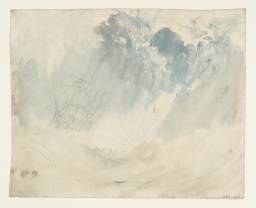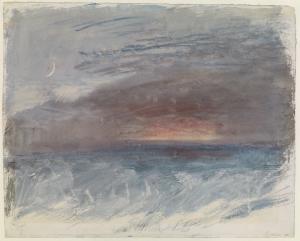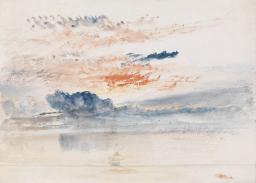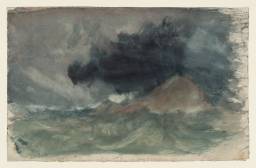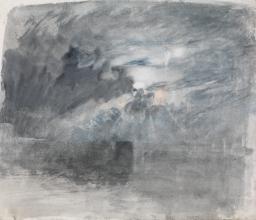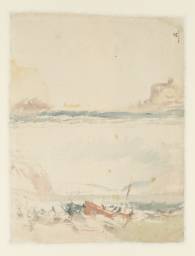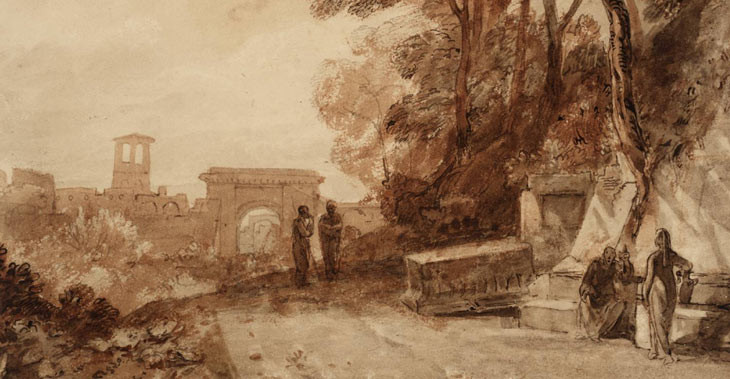Watercolour Designs for the ‘Little Liber’ or ‘Sequels to the Liber Studiorum’ c.1823–6
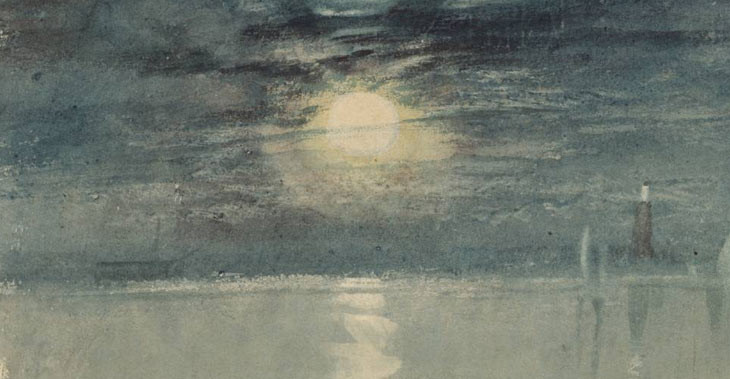
Shields Lighthouse c.1823-6
From the entry
In the long-established sequence followed here (see the checklist below), the so-called ‘Little Liber’ comprises twelve relatively generic, even ‘severe’, mezzotint landscape and seascape compositions acting as vehicles for strongly atmospheric effects of light and weather, ‘as mysteriously romantic as anything Turner ever did’. The engravings, ‘some of the least known and most original works in the entire history of printmaking’, and ‘perhaps the greatest masterpieces of the mezzotint’, were based on loose, sometimes highly coloured watercolour studies of which eight in the Turner Bequest at Tate are catalogued in the present section, together with a few closely related variants. Some were engraved on copper and some on steel, and they are mentioned in both editions of W.G. Rawlinson’s pioneering Liber Studiorum catalogue, though he doubted any direct link with the Liber Studiorum – a classified series ...
Accepted by the nation as part of the Turner Bequest 1856
References
In the long-established sequence followed here (see the checklist below), the so-called ‘Little Liber’ comprises twelve relatively generic, even ‘severe’,1 mezzotint landscape and seascape compositions acting as vehicles for strongly atmospheric effects of light and weather, ‘as mysteriously romantic as anything Turner ever did’.2 The engravings, ‘some of the least known and most original works in the entire history of printmaking’,3 and ‘perhaps the greatest masterpieces of the mezzotint’,4 were based on loose, sometimes highly coloured watercolour studies of which eight in the Turner Bequest at Tate are catalogued in the present section, together with a few closely related variants. Some were engraved on copper and some on steel, and they are mentioned in both editions of W.G. Rawlinson’s pioneering Liber Studiorum catalogue,5 though he doubted any direct link with the Liber Studiorum – a classified series of landscape compositions rendered in etching and mezzotint and published between 1807 and 1819, discussed in detail in the section of the present catalogue devoted to the watercolour studies held at Tate.
In his first Liber Studiorum catalogue (1878), Rawlinson relayed a ‘tradition’ that in the early stages of that project, Turner had taken up mezzotint himself after watching the engraver Charles Turner at work, the ‘Little Liber’ plates being the results; but he rightly found this unlikely, as ‘the style of the plates themselves ... would appear to point to a late period in Turner’s art’.6 Already by 1878, according to Rawlinson, the plates were ‘known as the “Sequel to Liber Studiorum”, ‘found unfinished at his death’, although ‘the intention and origin ... have always been a mystery’.7 Those to whom the plates were ‘known’ are not named, although they presumably included the small band of Turner scholars and print connoisseurs of the period who had already begun to codify the Liber Studiorum,8 epitomised by Rawlinson himself; John Ruskin had been aware of at least three of the prints by 18579 (see under Tate D25430, D25431, D25432; Turner Bequest CCLXIII 307, 308, 309a – the last being exhibited with an impression of the mezzotint at that time). At the end of his 1878 Liber Studiorum catalogue entries, Rawlinson again mentioned the compositions under consideration here: ‘Eleven small unpublished plates, engraved in pure mezzotint by Turner, are sometimes called the “Sequel to Liber Studiorum;” but I know of no reason whatever for connecting them with the work.’10
In his revised Liber Studiorum catalogue of 1906, Rawlinson returned to the issue, this time noting that Turner’s plates were ‘sometimes called “The Sequels to the Liber” or “The Little Liber”’, and had been ‘found in his house at his death’.11 This time he was surer of their chronological relationship to the Liber Studiorum, on technical and historical grounds: ‘It is certain, at least, that they did not precede but followed the Liber period, as many of them are on steel, and that metal was not used in England for engraving until after 1820.’12 Again, he included a note after his Liber catalogue entries, noting that the plates ‘are sometimes called “The Sequels to the Liber Studiorum,” or “The Little Liber.” I know of no reason for connecting these with the Liber.’13 By 1908, in the first volume of his general survey of Turner’s engravings, Rawlinson had refined his dating and suggested that the ‘Sequels to the Liber Studiorum’ were made ‘somewhere about 1826’14 towards the conclusion of the mezzotint Rivers of England and Ports of England series (engraved by Charles Turner, Thomas Lupton and others).15 In 1822 Lupton won a Society of Arts medal for a mezzotint engraving on steel, and Nick Savage has suggested that as ‘the most gifted of the younger members of the Liber engraving team’ he could have demonstrated the special qualities of the new plates to Turner.16
Although he may ultimately ‘have felt that for landscape such as his, the process inherently tended to be too black, and that it unavoidably missed the brilliance and luminousness which were his constant aim in his engravings’,17 Rawlinson suggested that Turner experimented here with mezzotint ‘effects of moonlight under various conditions of weather, atmosphere and surroundings’.18 In 1913, when he came to catalogue the ‘Little Liber’ in detail, Rawlinson included a twelfth design (The Medway – Thunderstorm with Rainbow, the last in the main checklist below); he also felt ‘compelled ... to abandon’ his idea that the series represented ‘moonlight under various conditions’,19 although he was surely right to emphasise Turner’s focus on weather and atmosphere expressed through light and shade rather than topography,20 including ‘some of the most intensely felt night-scenes in Turner’s art or anyone else’s’.21
In recent times only Marcel-Etienne Dupret has addressed these twelve canonical subjects systematically,22 although Luke Herrmann has also discussed the prints in some detail.23 The exhibiting of particular compositions, whether in the form of the mezzotints or the watercolour studies, has facilitated further discussions, cited here or under particular works.24 Andrew Wilton has observed that the watercolours show Turner’s development in the 1820s of a working method of applying broad areas of colour, with detail applied subsequently.25 Dupret and Gillian Forrester consider that the ‘Little Liber’ phase occurred in the early to mid-1820s, partly by comparison with the handling of Turner’s later, unpublished Liber Studiorum designs; the novelty of steel plates in the early 1820s is another factor, as Rawlinson had correctly observed (see above).26 As for the watercolours, concrete evidence is limited to occasional watermarks: 1810 for The Mewstone (Tate D17170; Turner Bequest CXCVI F); 1819 for Shields Lighthouse (Tate D25431; Turner Bequest CCLXIII 308) and its variant (Tate D25314; Turner Bequest CCLXIII 192); and 1823 for the Gloucester Cathedral variant (Tate D25334; Turner Bequest CCLXIII 212). The other variant of the latter (Tate D25368; Turner Bequest CCLXIII 246) has a watermark cut off at the edge of the sheet, leaving only ‘18’.
The ‘Little Liber’ plates demonstrate a transition between the established use of mezzotint over an etched outline in the Liber Studiorum towards purely tonal use of light and shade. Turner evidently found this creatively stimulating, even though the technique was stylistically incompatible with the completion of the Liber itself. Joseph R. Goldyne has characterised the suitability of the mezzotint process to ‘translate ... the special fluency of landscape illusion which characterized his work with watercolour’,27 facilitating ‘the engraved equivalent of watercolour on moist paper.’28 The tradition that the artist engraved the plates himself is unsubstantiated but generally accepted,29 particularly given that he had done the mezzotint work on a significant proportion of the Liber Studiorum plates;30 if so, the ‘Little Liber’ plates appear to have been the last he worked on directly.
Addressing the ‘Little Liber’ in his general catalogue of Turner’s watercolours, Wilton has suggested that he was ‘perhaps directly inspired’ by the theme and execution of F.C. Lewis’s 1826 mezzotint after Francis Danby’s painting Sunset at Sea after a Storm, exhibited at the Royal Academy in 1824 and at the British Institution the following year (Bristol Museum and Art Gallery), although Wilton dates Turner’s individual watercolours to about 1825, as noted in the individual entries here.31 Ian Warrell has noted that Turner ‘could not have missed the sensation created’ by the first showing of Danby’s painting;32 Dupret suggests that this unconfirmed factor ‘should not be overestimated’, loosely comparing Turner’s watercolour and gouache studies of the mid-1820s, which employ coloured (usually blue) papers and strong hues, to the tonal mezzotint process, making ‘the period between 1825 and 1830 ... plausible ... for the engravings’.33
There is no record of Turner’s mentioning or writing of the ‘Little Liber’ to friends or associates. Unlike the Liber Studiorum, covered elsewhere in the present catalogue), which was published and advertised, with working notes in several sketchbooks, there appears to be no contemporary documentation for the ‘Little Liber’ except for a list of subjects inside the front cover of the Worcester and Shrewsbury sketchbook, largely used on a tour of 1831 but watermarked 1820 (Tate D41053; Turner Bequest CCXXXIX): ‘Moonlight | Fish | Temple | Venice | Sunrise | Hare | Ship – Storm | Evening sunset’. The word ‘Copper’ appears to the right. These themes may, with varying degrees of certainty, relate to the ‘Little Liber’:
| Turner’s MS note | Possible ‘Little Liber’ subject (see main checklist below) |
| ‘Moonlight’ | Shields Lighthouse or St Michael’s Mount |
| ‘Fish’ | The Medway – Thunderstorm with Rainbow |
| ‘Temple’ | Paestum |
| ‘Venice’ | Catania, Sicily |
| ‘Sunrise’ | Study of Sea and Sky |
| ‘Hare’ | Gloucester Cathedral |
| ‘Ship – Storm’ | Ship in a Storm |
| ‘Evening sunset’ | The Evening Gun |
As the dating and significance of this list remain unresolved, an approximate range of 1823–6 has been applied to all ‘Little Liber’ watercolours in the present catalogue, representing a combination of the dates most frequently applied in the past. Beyond these parameters, Luke Herrmann has suggested that work might have begun ‘quite soon’ after Turner returned from his Italian tour in 1820, ‘when the steel plate was something really new’;34 for James Hamilton’s suggestion of a rather later timescale, see under Tate D25430 (Turner Bequest CCLXIII 307), which he links to a tour of 1830.
Evelyn Joll, ‘Turner: the Fourth Decade. Watercolours 1820–1830’, Turner Society News, no.58, August 1991, p.6; see also Forrester 2001, p.174.
See [J.E. Taylor and Henry Vaughan], Exhibition Illustrative of Turner’s Liber Studiorum, Containing Choice Impressions of the First States, Etchings, Touched Proofs, together with the Unpublished Plates, and a Few Original Drawings for the Work, exhibition catalogue, Burlington Fine Arts Club, London 1872; see also Rawlinson I 1908, p.xliv.
See ‘Catalogue of the Sketches and Drawings by J.M.W. Turner, R.A. Exhibited in Marlborough House in the Year 1857–8’ in Cook and Wedderburn 1904, p.280.
Including Butlin, Wilton and Gage 1974, p.95; Wilton 1975, pp.62–3; White 1977, pp.79–80; Lyles and Perkins 1989, pp.58–62; Warrell 1991, pp.10–11, 37–9; Gage 1994, pp.28–9, 154; Warrell 1994, p.138; Forrester 1996, p.21; Shanes 1997, pp.27–8; and Warrell 2004, pp.82–3.
See Dupret 1989, pp.32, 34; Forrester 1996, pp.21, 138; Forrester 2001, p.174; Wilton 1980, pp.156–63; and Gage 1987, p.207.
Summarised in Dupret 1989, p.34 from earlier sources; see also the Liber Studiorum entries in the present Turner Bequest catalogue.
Checklist
The concordance below sets out the twelve traditional ‘Little Liber’ subjects, with references to the watercolour studies at Tate covered in the present section of the Turner Bequest catalogue. While the Liber Studiorum has been the subject of full catalogues by Rawlinson and Finberg, arranged in a standard numerical sequence, the only comprehensive listings of the ‘Little Liber’ subjects have been within Rawlinson’s catalogue of engravings after Turner other than the Liber, where the engraved designs are nos.799–809a within the overall sequence, and in the Turner Studies article by Dupret, where they are set out in the same order and numbered 1–12. In addition, variants of Shields Lighthouse and Gloucester Cathedral are included. Any preliminary pencil topographical studies or other treatments of the subject are discussed in the individual entries, and brief notes on the subjects not represented by watercolour studies at Tate are also given, along with references to Andrew Wilton’s general catalogue of Turner’s watercolours. Impressions of the mezzotints in the Tate collection are noted.
Paestum
Pink and Yellow Sky (Tate D36213; Turner Bequest CCCLXIV 352), a watercolour study formerly known as ‘Sea-Piece’,38 has been tentatively related to this composition by Eric Shanes;39 the features in common are a low, dark horizon and heavy clouds, but the latter differ in their formation and there is no indication of buildings, so D36213 has not been catalogued in the present ‘Little Liber’ section.
[The Evening Gun
The sun setting through clouds over the sea, seen from a beach in the foreground, with a warship firing a signal in the distance on the right, partly obscured by a boat near the shore.44]
Shields Lighthouse
Related watercolour: Tate D25314; Turner Bequest CCLXIII 192
St Michael’s Mount
Watercolour: Tate D25434; Turner Bequest CCLXIII 311
Ship in a Storm
The Mewstone
[Catania, Sicily
Watercolour: Museum of Fine Arts, Boston, Massachusetts (Wilton no.774)]57
Study of Sea and Sky
Watercolour: Tate D25479; Turner Bequest CCLXIII 356
Bridge and Monument
Watercolour: Tate D17193; Turner Bequest CXCVII C
[Ship and Cutter
Watercolour: Museum of Fine Arts, Boston (Wilton no.777)66
In heavy seas and against a stormy sky, a cutter (a small, single-masted boat) in the right foreground sails to the left; in the left distance a ship, only pencilled in in the Boston design and left as a silhouette in the engraving, travels to the right.]
Gloucester Cathedral (‘Boston Stump’ or ‘The Hare’)
Evening (Tate D35956; Turner Bequest CCCLXIV 113), a watercolour study, has been tentatively related to this composition by Eric Shanes;72 the similarities are limited to the vertical feature on the left and the sunset effect. D35956 is much looser, perhaps representing a coastal subject, and has not been catalogued in the present section.
[The Medway – Thunderstorm with Rainbow
Watercolour design: private collection (Wilton no.765, as ‘On the Medway’, although not categorised as a ‘Little Liber’ subject)73
Although they are not related compositionally to the engraved subjects, Andrew Wilton has also listed the following watercolours as ‘connected’76 with the ‘Little Liber’, on stylistic or technical grounds, dating them variously within the decade 1820–30:
Sea Breaking on a Pier: Stormy Skies (private collection)77
Cloud and Sunlight at Sea (Ashmolean Museum, Oxford)78
Sunset over the River (Museum of Art, Rhode Island School of Design, Providence)79
Study of clouds over the sea. Verso: Evening Sky (private collection)80
Sunrise off Margate (private collection)83
A further watercolour, showing A Rainstorm at Sea (private collection) with a low horizon and prominent cloud formations, has been speculatively linked to the ‘Little Liber’;84 as with those noted above, the comparison is on stylistic rather than compositional grounds.
Most of the engraved plates were found in Turner’s studio after his death, and according to Rawlinson and Dupret, who differ on details under their individual entries, they were sold along with Turner’s own holdings of his engravings in the five sales from the estate at Christie’s, London in 1873 and 1874 (copies of catalogues in the Tate Britain Prints and Drawings Room). Some impressions were printed by Sir Francis Seymour Haden before the sales, and others were made later from retouched plates.85 Dupret states that the catalogues ‘do not give any detailed account of the plates and trial proofs’,86 but there do appear to be a small number of relevant lots towards the end of the first sale, on 24 March 1873. Following nos.913–23, ‘Copper plates of the unpublished numbers of the “Liber Studiorum.”’, come nos.924–30, ‘Other plates’, of which only three appear likely to be ‘Little Liber’ subjects:87
| Lot | Christie’s title | Watercolour study | MS price in Tate copy (£ s d) |
| 926 | Study of Sea and Sky | Probably the study of the same name | 26.5. – |
| 927 | Seapiece, with Shipping at Night | Possibly Shields Lighthouse or Ship in a Storm | 57.15. – |
| 928 | Gloucester Cathedral | Presumably the study of the same name | 21. –. – |
The plates for Ship in a Storm (Tate D25432; Turner Bequest CCLXIII 309a) and Ship and Cutter were both donated to the British Museum, London, by the dealer Colnaghi in 1942. Of the other designs for which there are watercolours in the Turner Bequest, Dupret notes that the steel plates of St Michael’s Mount (see Tate D25434; Turner Bequest CCLXIII 311) and Bridge and Monument (see Tate D17193; Turner Bequest CXCVII C) were ‘sold in 1873’.88 Following Dupret, Forrester states that three copper plates and four steel plates ‘are still known’,89 although Dupret actually describes three copper and five steel plates in his entries for the individual designs.90
There are significant holdings of ‘Little Liber’ prints at the British Museum and University College London, the Museum of Fine Arts, Boston, and the Yale Center for British Art, New Haven.91
Note: Ongoing research across the Turner Bequest has led to the inclusion of a subsection of ‘colour beginnings’ which appear much the same mode as the canonical ‘Little Liber’ designs, if not actually intended to inform additional prints in the series. The text of the present Introduction remains otherwise unchanged.
A.J. Finberg, A Complete Inventory of the Drawings of the Turner Bequest, London 1909, vol.II, p.1204.
Eric Shanes, Turner’s Watercolour Explorations 1810–1842, exhibition catalogue, Tate Gallery, London 1997, p.98 under ‘“Liber Studiorum” and “Little Liber” Series’, as ‘?Related to TB CCCLXIV 142 and 224’; also listed p.102 under ‘Sky Sketches’.
For an early discussion see S. Colvin, ‘Turner’s “Evening Gun”’, Portfolio, vol.3, 1872, pp.75–6, cited in Wilton 1980, p.163 and Dupret 1989, p.47 note 3.
Shanes 1997, pp.98 under ‘“Liber Studiorum” and “Little Liber” Series’, as ‘Sky sketch, possibly related to [CCLXIII] 311’, 101 under ‘Sea Sketches and Studies’, 102 under ‘Sky Sketches’.
Shanes 1997, pp.94 under ‘Boston Stump/Gloucester Cathedral’, 98 under ‘“Liber Studiorum” and “Little Liber” Series’ as ‘?Study for “Gloucester Cathedral” (also known as “Boston Stump” and “The Hare”)’
Martin Butlin and Evelyn Joll, The Paintings of J.M.W. Turner, revised ed., New Haven and London 1984, p.159 no.259a, pl.260, as ‘Storm off the Farne Island’, ‘Oil(?) on paper’.
English Watercolours and Drawings: Agnew’s 122nd Annual Exhibition, exhibition catalogue, Thos Agnew & Sons, London 1995, unpaginated, no.45, reproduced in colour; see also Agnew’s advertisement, Turner Society News, no.69, March 1995, p.[8], reproduced.
Catalogue of the First Portion of the Valuable Engravings from the Works of the Late J.M.W. Turner, R.A.; Comprising the Whole of the Impressions, Etchings and Some Engraver’s Proofs of the Liber Studiorum; Also, the Etchings of Some of the Steel and Copper Plates of Eleven Unpublished Subjects for the Same Work; the Copper-plate of Calais Pier, Engraved by T.O. Lupton; and Several Other Unpublished Plates, Late the Property of J.M.W. Turner, R.A., Christie, Manson & Woods, London 24 March 1873, p.48.
Revised September 2016
How to cite
Matthew Imms, ‘Watercolour Designs for the ‘Little Liber’ or ‘Sequels to the Liber Studiorum’ c.1823–6’, November 2011, in David Blayney Brown (ed.), J.M.W. Turner: Sketchbooks, Drawings and Watercolours, Tate Research Publication, December 2012, https://www


